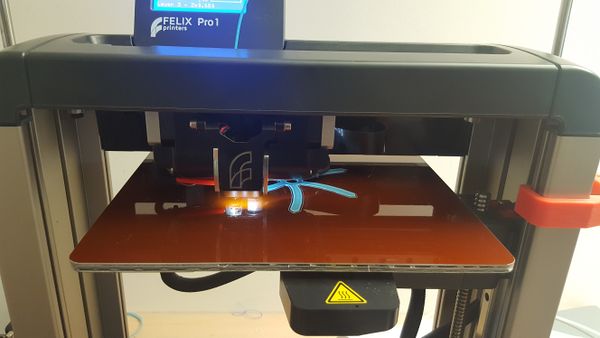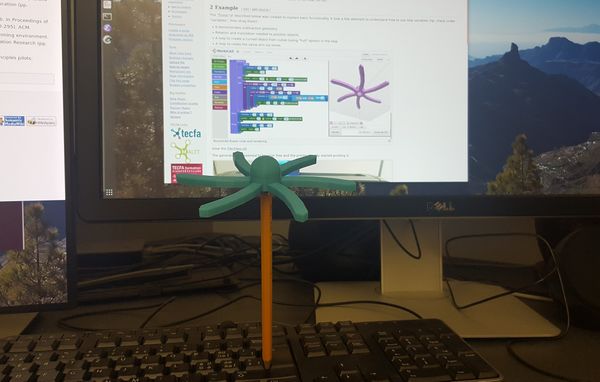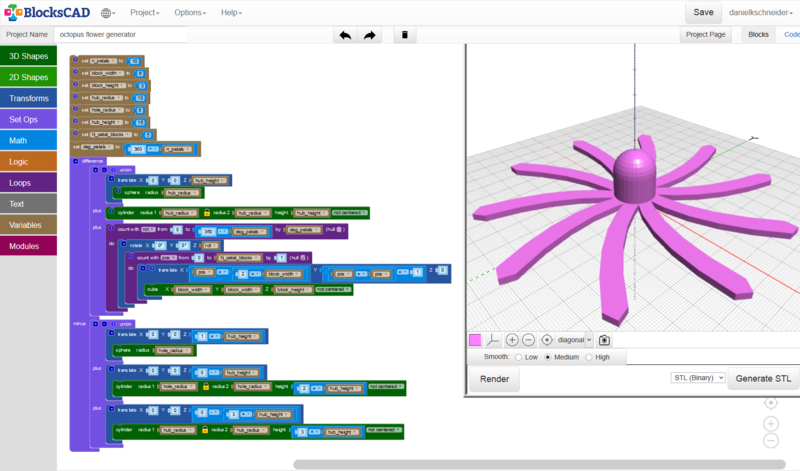BlocksCAD: Difference between revisions
m (→Introduction) |
m (→Bibliography) |
||
| Line 139: | Line 139: | ||
[[category:programming]] | [[category:programming]] | ||
[[category: 3D printing]] | [[category: 3D printing]] | ||
[[category: computational making]] | |||
Revision as of 21:22, 24 January 2020
Introduction
BlocksCAD is a scratch-like programming environment to create 3D objects. It was developed with the sponsorship of the Defense Advanced Research Projects Agency (DARPA) and the code is licensed GPLv3 or later. At the bottom of a project page (oct. 2018) we found the following definition: “BlocksCAD is an education technology company dedicated to creating tools that help students of all ages pursue their love of science, technology, engineering, art, and math (STEAM). Our signature product, BlocksCAD, is a cloud-based 3D modeling tool that encourages users to learn math, computational thinking and coding concepts through visualization and designing models to be 3D printed.”
The ownership and copyright of user-created models is not clear (to us).
If we understood right, BlocksCAD is implemented with Blockly, a a JavaScript library for building visual programming editors like Scratch. BlocksCad code will generate OpenSCAD code that one can export (code button on top right or the design window). Otherwise the STL model will be generated on the server. Playing with BlocksCAD is therefore also a way to learn OpenSCAD.
Beetle Blocks is a similar environment.
Examples
A simple flower
The "flower" described below was created to explore basic functionality. It took a few attempts to understand how to use loop variables (tip: check under "variables", then drag them).
- It demonstrates subtractive geometry
- Rotation and translation needed to position objects
- A loop to create a curved object from cubes (using "hull" option) in the loop
- A loop to rotate the same arm six times.
View the
The generated STL seemed to be error free and the printer happily started printing it:
A flower that is parameterized
The next example shows how to use parameters, i.e. a user can change seven different parameters to create different shapes. See the comments in the exported OpenSCAD code below.
One generated example can seen in the following picture:
Generated OpenSCAD code:
//!OpenSCAD
// Number of petals. A number between 2 and 15 maybe.
n_petals = 8;
// Building block of a petal. Each petal is defined as a string of block with a "hull" around it.
block_width = 10;
// Building block of a petal. Height should be anything that is printable, e.g. between 0.5 and 20.
block_height = 2;
// Radius of the hub. A good value is 10, i.e. a width of 2cm.
hub_radius = 10;
// Radius of the hole. 4-5 mm is about the size of a pen. Must be at least 1.5 smaller than radius.
hole_radius = 5;
// Height of the hub in the middle. Something between 5 and 30 ?
hub_height = 15;
// Petal length in terms of blocks. Try between 2 and 10.
N_petal_blocks = 5;
deg_petals = 360 / n_petals;
difference() {
// Flower without the hole. It has a hub plus petals.
union(){
translate([0, 0, hub_height]){
// Sphere embedded on top of the hub
sphere(r=hub_radius);
}
// The lower part of the hub
cylinder(r1=hub_radius, r2=hub_radius, h=hub_height, center=false);
// Loop to create N petals. Each one is rotated
for (rot = [0 : abs(deg_petals) : 360 - deg_petals]) {
rotate([0, 0, rot]){
// Untick hull for a postmodern experience...
// chain hull
for (pos = [0 : abs(1) : N_petal_blocks - 1]) {
hull() {
// This formula will create a curved line. You can try others....
translate([(pos * (2 * block_width)), ((pos * pos) * 1), 0]){
cube([block_width, block_width, block_height], center=false);
}
// This formula will create a curved line. You can try others....
translate([((pos + 1) * (2 * block_width)), (((pos + 1) * (pos + 1)) * 1), 0]){
cube([block_width, block_width, block_height], center=false);
}
} // end hull (in loop)
} // end loop
}
}
}
// Three objects that will be subtracted to create the hole. One stick plus a ball on top. The cylinder at the bottom will shave off stuff that inhibits 3D printing.
union(){
translate([0, 0, (1 * hub_height)]){
sphere(r=hole_radius);
}
translate([0, 0, (0 - hub_height)]){
cylinder(r1=hole_radius, r2=hole_radius, h=(2 * hub_height), center=false);
}
translate([0, 0, (0 - 3 * hub_height)]){
cylinder(r1=hub_radius, r2=hub_radius, h=(3 * hub_height), center=false);
}
}
}
Alternatives
Links
Official
- blockscad3d.com/
- Parent FAQs
- Community, featured projects, blog posts, news.
- On Twitter
In french
- BlocksCAD (en français) at http://blockly.technologiescollege.fr/
- BlocksCAD : un logiciel de CAO pour concevoir rapidement des pièces à imprimer en 3D (avec exemples assez avancés)
- Guides des choses Tutoriel/transparents très complets de Cyril Vignet.
Others
- BlocksCAD (In German) A concise introduction.
Bibliography
- Berdik, C. (2017). Kids Code Their Own 3D Creations with New Blocks-Based Design Program. Tech Directions, 76(9), 23.
- Williams, K. (2015). Girls, Boys, and'Bots: The St. Clare's robotics team [Pipelining: Attractive Programs for Women]. IEEE Women in Engineering Magazine, 9(1), 25-28.
- Chytas, C., Diethelm, I., & Tsilingiris, A. (2018, April). Learning programming through design: An analysis of parametric design projects in digital fabrication labs and an online makerspace. In Global Engineering Education Conference (EDUCON), 2018 IEEE (pp. 1978-1987). IEEE.
- Chytas, C., Diethelm, I., & Lund, M. Parametric Design and Digital Fabrication in Computer Science Education.
- Romagosa Carrasquer, Bernat. (2016). From the turtle to the beetle. Universitat Oberta de Catalunya http://openaccess.uoc.edu/webapps/o2/handle/10609/52807




